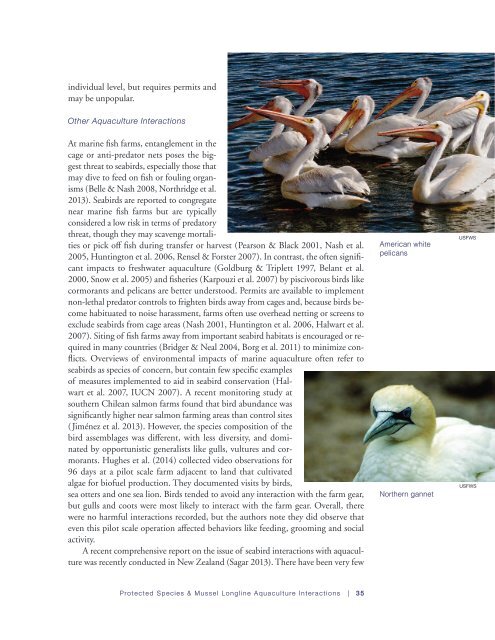Protected Species and Marine Aquaculture Interactions
x9Jh2
x9Jh2
Create successful ePaper yourself
Turn your PDF publications into a flip-book with our unique Google optimized e-Paper software.
individual level, but requires permits <strong>and</strong><br />
may be unpopular.<br />
Other <strong>Aquaculture</strong> <strong>Interactions</strong><br />
At marine fish farms, entanglement in the<br />
cage or anti-predator nets poses the big -<br />
gest threat to seabirds, especially those that<br />
may dive to feed on fish or fouling organisms<br />
(Belle & Nash 2008, Northridge et al.<br />
2013). Seabirds are reported to congregate<br />
near marine fish farms but are typically<br />
considered a low risk in terms of preda tory<br />
threat, though they may scavenge mortalities<br />
or pick off fish during transfer or harvest (Pearson & Black 2001, Nash et al.<br />
2005, Huntington et al. 2006, Rensel & Forster 2007). In contrast, the often significant<br />
impacts to freshwater aquaculture (Goldburg & Triplett 1997, Belant et al.<br />
2000, Snow et al. 2005) <strong>and</strong> fisheries (Karpouzi et al. 2007) by piscivorous birds like<br />
cormorants <strong>and</strong> pelicans are better understood. Permits are available to implement<br />
non-lethal predator controls to frighten birds away from cages <strong>and</strong>, because birds become<br />
habituated to noise harassment, farms often use overhead netting or screens to<br />
exclude seabirds from cage areas (Nash 2001, Huntington et al. 2006, Halwart et al.<br />
2007). Siting of fish farms away from important seabird habitats is encouraged or required<br />
in many countries (Bridger & Neal 2004, Borg et al. 2011) to minimize con -<br />
flicts. Overviews of environmental impacts of marine aquaculture often refer to<br />
seabirds as species of concern, but contain few specific examples<br />
of measures implemented to aid in seabird conservation (Halwart<br />
et al. 2007, IUCN 2007). A recent monitoring study at<br />
south ern Chilean salmon farms found that bird abundance was<br />
significantly higher near salmon farming areas than control sites<br />
(Jiménez et al. 2013). However, the species composition of the<br />
bird assemblages was different, with less diversity, <strong>and</strong> dominated<br />
by opportunistic generalists like gulls, vultures <strong>and</strong> cormorants.<br />
Hughes et al. (2014) collected video observations for<br />
96 days at a pilot scale farm adjacent to l<strong>and</strong> that cultivated<br />
algae for biofuel production. They documented visits by birds,<br />
sea otters <strong>and</strong> one sea lion. Birds tended to avoid any interaction with the farm gear,<br />
but gulls <strong>and</strong> coots were most likely to interact with the farm gear. Overall, there<br />
were no harmful interactions recorded, but the authors note they did observe that<br />
even this pilot scale operation affected behaviors like feeding, grooming <strong>and</strong> social<br />
activity.<br />
A recent comprehensive report on the issue of seabird interactions with aquaculture<br />
was recently conducted in New Zeal<strong>and</strong> (Sagar 2013). There have been very few<br />
American white<br />
pelicans<br />
Northern gannet<br />
uSFWS<br />
uSFWS<br />
<strong>Protected</strong> <strong>Species</strong> & Mussel longline aquaculture interactions | 35


